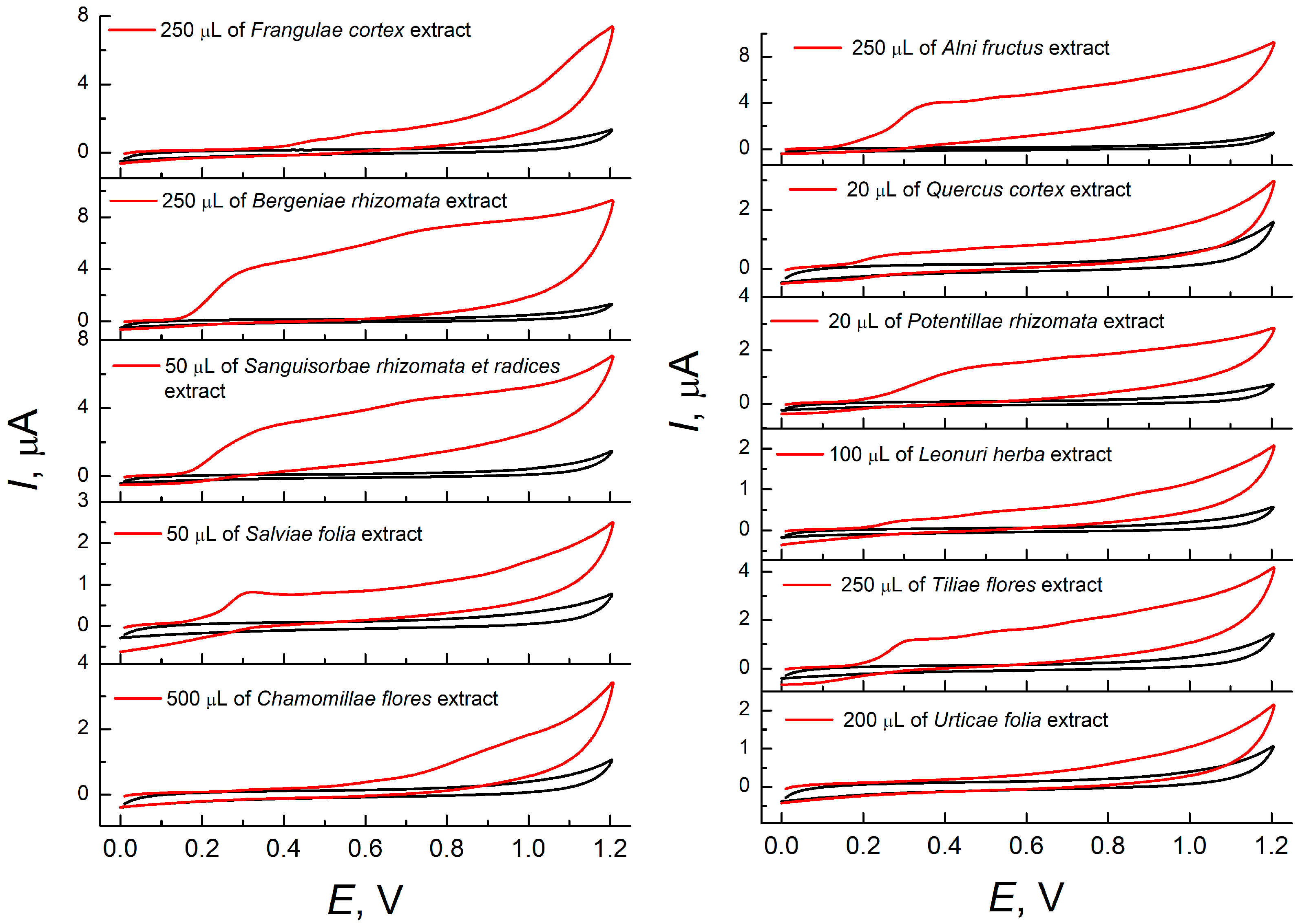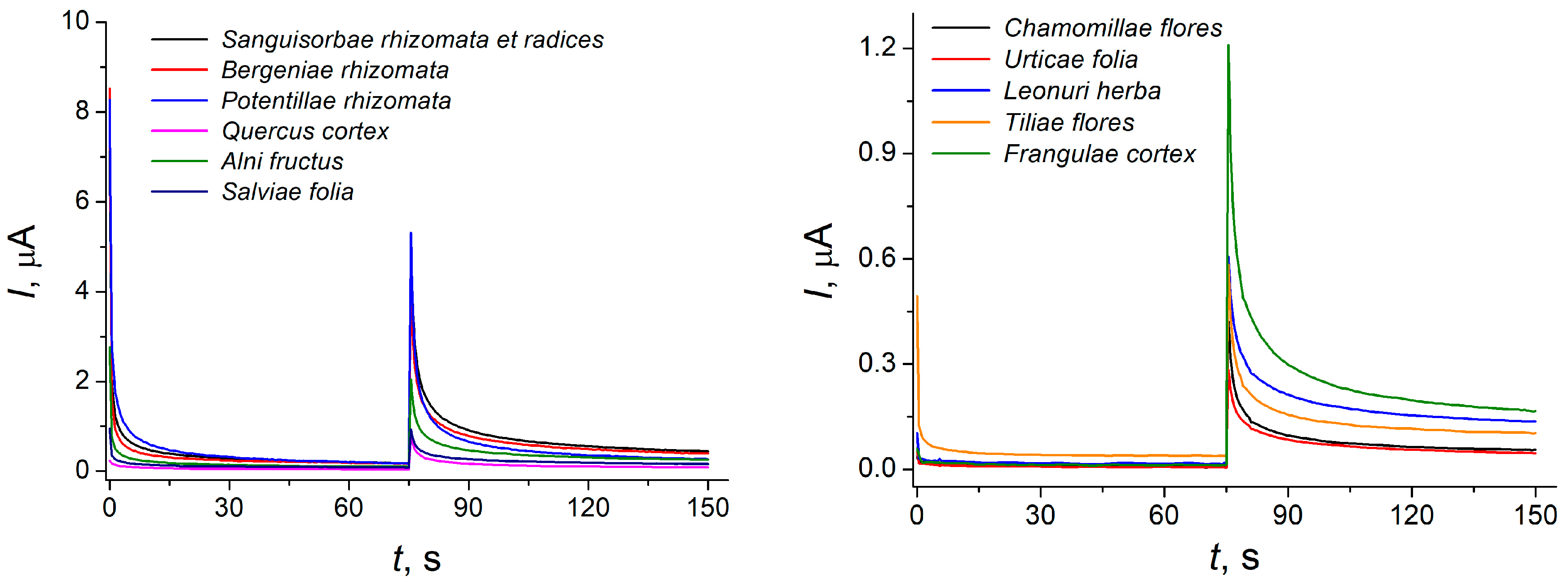Two-Step Chronoamperometric Determination of Antioxidant Capacity of Water Extracts from Medicinal Plants †
Abstract
1. Introduction
2. Materials and Methods
3. Results and Discussion
3.1. Voltammetric Behavior of Water Extracts from Medicinal Plants
3.2. Chronoamperometry of Water Extracts from Medicinal Plants
4. Conclusions
Author Contributions
Funding
Institutional Review Board Statement
Informed Consent Statement
Data Availability Statement
Conflicts of Interest
References
- Tewari, A.; Tiwari, S. (Eds.) Synthesis of Medicinal Agents from Plants; Elsevier: Amsterdam, The Netherlands, 2018; 357p. [Google Scholar]
- Capasso, F.; Gaginella, T.S.; Grandolini, G.; Izzo, A.A. Phytotherapy: A Quick Reference to Herbal Medicine; Springer: Berlin/Heidelberg, Germany, 2003; 424p. [Google Scholar] [CrossRef]
- Sofowora, A.; Ogunbodede, E.; Onayade, A. The role and place of medicinal plants in the strategies for disease prevention. Afr. J. Tradit. Complement. Altern. Med. 2013, 10, 210–229. [Google Scholar] [CrossRef] [PubMed]
- Parham, S.; Kharazi, A.Z.; Bakhsheshi-Rad, H.R.; Nur, H.; Ismail, A.F.; Sharif, S.; RamaKrishna, S.; Berto, F. Antioxidant, antimicrobial and antiviral properties of herbal materials. Antioxidants 2020, 9, 1309. [Google Scholar] [CrossRef] [PubMed]
- Ziyatdinova, G.; Kalmykova, A. Electrochemical characterization of the antioxidant properties of medicinal plants and products: A review. Molecules 2023, 28, 2308. [Google Scholar] [CrossRef] [PubMed]
- Kalmykova, A.; Ziyatdinova, G. Screening of essential oil antioxidant capacity using electrode modified with carboxylated multi-walled carbon nanotubes. Eng. Proc. 2022, 27, 48. [Google Scholar] [CrossRef]
- Ziyatdinova, G.; Kozlova, E.; Morozova, E.; Budnikov, H. Chronocoulometric method for the evaluation of antioxidant capacity of medicinal plant tinctures. Anal. Methods 2018, 10, 4995–5003. [Google Scholar] [CrossRef]
- Fu, L.; Xu, B.-T.; Gan, R.-Y.; Zhang, Y.; Xu, X.-R.; Xia, E.-Q.; Li, H.-B. Total phenolic contents and antioxidant capacities of herbal and tea infusions. Int. J. Mol. Sci. 2011, 12, 2112–2124. [Google Scholar] [CrossRef] [PubMed]
- Brand-Williams, W.; Cuvelier, M.E.; Berset, C. Use of a free radical method to evaluate antioxidant activity. LWT Food Sci. Technol. 1995, 28, 25–30. [Google Scholar] [CrossRef]
- Evans, W.C. Trease and Evans’ Pharmacognosy, 16th ed.; Saunders Ltd.: London, UK, 2009; 600p. [Google Scholar]
- Akhtar, N.; Ihsan-ul-Haq; Mirza, B. Phytochemical analysis and comprehensive evaluation of antimicrobial and antioxidant properties of 61 medicinal plant species. Arab. J. Chem. 2018, 11, 1223–1235. [Google Scholar] [CrossRef]
- Pullaiah, T. (Ed.) Phytochemical Composition and Pharmacy of Medicinal Plants; CRC Press: New York, NY, USA, 2023; 1292p. [Google Scholar]
- Ziyatdinova, G.; Ziganshina, E.; Romashkina, S.; Budnikov, H. Highly sensitive amperometric sensor for eugenol quantification based on CeO2 nanoparticles and surfactants. Electroanalysis 2017, 29, 1197–1204. [Google Scholar] [CrossRef]
- Wei, Y.; Wang, G.; Li, M.; Wang, C.; Fang, B. Determination of rutin using a CeO2 nanoparticle-modified electrode. Microchim. Acta 2007, 158, 269–274. [Google Scholar] [CrossRef]
- Ziyatdinova, G.; Yakupova, E.; Davletshin, R. Voltammetric determination of hesperidin on the electrode modified with SnO2 nanoparticles and surfactants. Electroanalysis 2021, 33, 2417–2427. [Google Scholar] [CrossRef]
- Blasco, A.J.; Rogerio, M.C.; González, M.C.; Escarpa, A. “Electrochemical Index” as a screening method to determine “total polyphenolics” in foods: A proposal. Anal. Chim. Acta 2005, 539, 237–244. [Google Scholar] [CrossRef]
- Haque, M.A.; Morozova, K.; Ferrentino, G.; Scampicchio, M. Electrochemical methods to evaluate the antioxidant activity and capacity of foods: A review. Electroanalysis 2021, 33, 1419–1435. [Google Scholar] [CrossRef]
- Lone, A.S.; Shahnawaz, M.; Singh, N.; Pervez, S.; Ravindran, K.C. Metabolomic and antioxidant potential analyses of the rhizome and leaves of Podophyllum hexandrum Royle: A comparative account. Biocatal. Agric. Biotechnol. 2023, 52, 102836. [Google Scholar] [CrossRef]
- Liu, W.; Zhang, Z.; Zhang, T.; Qiao, Q.; Hou, X. Phenolic profiles and antioxidant activity in different organs of Sinopodophyllum hexandrum. Front. Plant Sci. 2022, 13, 1037582. [Google Scholar] [CrossRef] [PubMed]
- Krupanidhi, A.M.; Prakash, D.; Anusha, M.M.; Deepika, B.V.; Sameera, H.R.; Srinivas, G.; Soundarya, R. Antioxidant properties of medicinal plants: A review. Sys. Rev. Pharm. 2022, 13, 457–463. Available online: https://www.sysrevpharm.org/articles/antioxidant-properties-of-medicinal-plants-a-review.pdf (accessed on 29 July 2022).


| Medicinal Plant Material | Bare GCE | GCE Modified with Mixed CeO2 and SnO2 NPs | ||||
|---|---|---|---|---|---|---|
| Val, μL | Eox, V | I, μA | Val, μL | Eox, V | I, μA | |
| Alni fructus | 250 | 0.34; 0.52 | 0.97 ± 0.08; 0.070 ± 0.005 | 50 | 0.33, 0.52 | 0.26 ± 0.04; 0.025 ± 0.002 |
| Quercus cortex | 20 | 0.25; 0.50 | 0.11 ± 0.04; 0.014 ± 0.002 | 20 | 0.34 | 0.18 ± 0.02 |
| Frangulae cortex | 250 | 0.47; 0.59 | 0.060 ± 0.03; 0.076 ± 0.002 | 500 | 0.44, 0.61 | 0.28 ± 0.04; 0.16 ± 0.01 |
| Potentillae rhizomata | 20 | 0.43; 0.68 | 0.26 ± 0.02; 0.032 ± 0.001 | 20 | 0.32 | 0.84 ± 0.06 |
| Bergeniae rhizomata | 250 | 0.29; 0.76 | 1.4 ± 0.09; 0.41 ± 0.03 | 100 | 0.32, 0.74 | 1.1 ± 0.1; 0.044 ± 0.008 |
| Sanguisorbae rhizomata et radices | 50 | 0.33; 0.72 | 0.87 ± 0.07; 0.14 ± 0.02 | 20 | 0.35, 0.74 | 0.60 ± 0.01; 0.017 ± 0.001 |
| Leonuri herba | 100 | 0.29; 0.51; 0.87 | 0.053 ± 0.001; 0.017 ± 0.002; 0.009 ± 0.002 | 100 | 0.31, 0.53 | 0.011 ± 0.002; 0.018 ± 0.002 |
| Tiliae flores | 250 | 0.30; 0.52; 0.75 | 0.40 ± 0.05; 0.051 ± 0.005, 0.025 ± 0.003 | 250 | 0.39, 0.76 | 0.45 ± 0.02; 0.017 ± 0.001 |
| Salviae folia | 50 | 0.31 | 0.45 ± 0.02 | 50 | 0.34 | 0.59 ± 0.04 |
| Urticae folia | 250 | — | — | 500 | 0.90 | 0.016 ± 0.003 |
| Chamomillae flores | 500 | 0.32; 0.97 | 0.017 ± 0.02; 0.015 ± 0.002 | 500 | 0.32 | 0.023 ± 0.002 |
| Medicinal Plant Material | AOC400, μA per 100 mL | RSD, % | AOC900, μA per 100 mL | RSD, % |
|---|---|---|---|---|
| Alni fructus | 747 ± 57 | 3.1 | 2053 ± 81 | 3.2 |
| Quercus cortex | 938 ± 51 | 2.2 | 1860 ± 86 | 1.9 |
| Frangulae cortex | 80.0 ± 0.9 | 0.88 | 1320 ± 99 | 3.0 |
| Potentillae rhizomata | 1404 ± 101 | 2.9 | 2204 ± 101 | 1.8 |
| Bergeniae rhizomata | 1360 ± 52 | 2.4 | 2840 ± 99 | 1.4 |
| Sanguisorbae rhizomata et radices | 1347 ± 57 | 1.7 | 3400 ± 99 | 1.2 |
| Leonuri herba | 112 ± 5 | 2.9 | 1073 ± 40 | 1.5 |
| Tiliae flores | 297 ± 18 | 3.9 | 832 ± 45 | 3.4 |
| Salviae folia | 518 ± 37 | 5.7 | 1104 ± 60 | 2.2 |
| Urticae folia | 33 ± 2 | 5.5 | 325 ± 10 | 1.3 |
| Chamomillae flores | 43 ± 3 | 6.8 | 403 ± 23 | 2.3 |
| Antioxidant Parameter | Total Phenolic Content, mg Gallic Acid per 100 mL | Antioxidant Capacity Toward DPPH, % |
|---|---|---|
| AOC400, μA per 100 mL | 0.8977 | 0.9311 |
| AOC900, μA per 100 mL | 0.9249 | 0.8803 |
Disclaimer/Publisher’s Note: The statements, opinions and data contained in all publications are solely those of the individual author(s) and contributor(s) and not of MDPI and/or the editor(s). MDPI and/or the editor(s) disclaim responsibility for any injury to people or property resulting from any ideas, methods, instructions or products referred to in the content. |
© 2024 by the authors. Licensee MDPI, Basel, Switzerland. This article is an open access article distributed under the terms and conditions of the Creative Commons Attribution (CC BY) license (https://creativecommons.org/licenses/by/4.0/).
Share and Cite
Lukonina, Y.; Ziyatdinova, G. Two-Step Chronoamperometric Determination of Antioxidant Capacity of Water Extracts from Medicinal Plants. Eng. Proc. 2024, 82, 58. https://doi.org/10.3390/ecsa-11-20467
Lukonina Y, Ziyatdinova G. Two-Step Chronoamperometric Determination of Antioxidant Capacity of Water Extracts from Medicinal Plants. Engineering Proceedings. 2024; 82(1):58. https://doi.org/10.3390/ecsa-11-20467
Chicago/Turabian StyleLukonina, Yuliya, and Guzel Ziyatdinova. 2024. "Two-Step Chronoamperometric Determination of Antioxidant Capacity of Water Extracts from Medicinal Plants" Engineering Proceedings 82, no. 1: 58. https://doi.org/10.3390/ecsa-11-20467
APA StyleLukonina, Y., & Ziyatdinova, G. (2024). Two-Step Chronoamperometric Determination of Antioxidant Capacity of Water Extracts from Medicinal Plants. Engineering Proceedings, 82(1), 58. https://doi.org/10.3390/ecsa-11-20467







